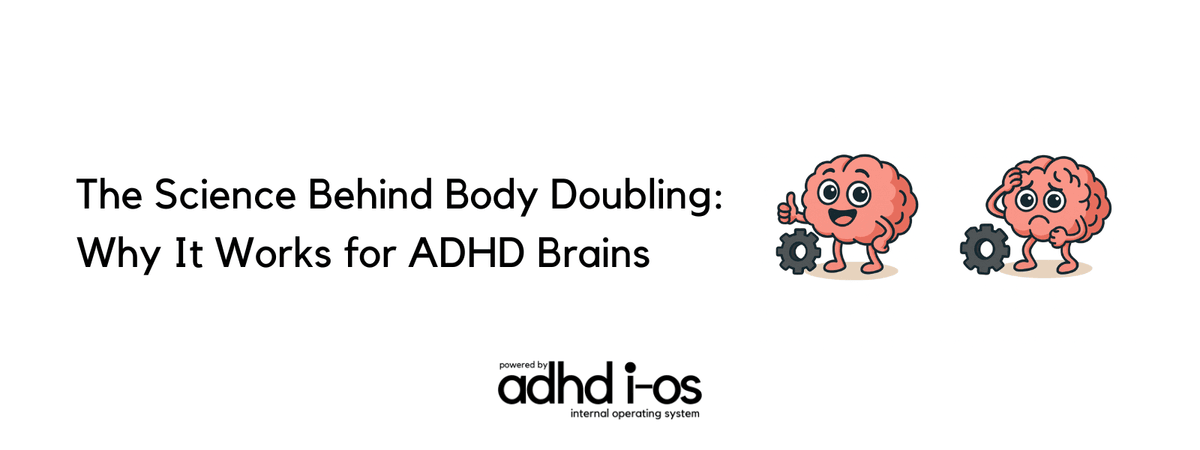The Science Behind Body Doubling: Why It Works for ADHD Brains
The Science Behind Body Doubling: Why It Works for ADHD Brains
The Science Behind Body Doubling: Why It Works for ADHD Brains
Ever noticed how you suddenly get things done... just because someone else is in the room?
You’re not imagining it. That invisible productivity boost has a name: body doubling.
Whether it’s a coworker on Zoom, a friend folding laundry nearby, or even a quiet stranger on a livestream, something about not being alone flips a switch. For ADHD brains especially, body doubling isn’t just a trend. It’s a neuroscience-backed strategy that helps you go from stuck to started by tapping into your brain’s natural support systems.
Let’s explore what body doubling is, why it works, and how you can make it work for you.

What Is Body Doubling?
At its core, body doubling is a productivity technique where another person, whether physically or virtually, is present while you work. They don’t coach, nag, or supervise. They just exist in the same space.
And somehow… that helps.
In the ADHD world, this strategy is a beloved go-to for tackling tasks that feel impossible to start. That external presence creates just enough structure to jumpstart motivation, especially when your internal drive has left the building.
Why It Works: The Brain Science Behind It
So what’s actually going on in the brain when body doubling works? Let’s look at the quiet but powerful systems that kick into gear when you’re not alone.
Social Accountability (Without the Pressure)
Just having someone nearby and doing their own thing adds a low-stakes sense of visibility. You’re not being watched, but your brain feels like someone might notice if you zone out completely. That gentle accountability is often enough to keep you engaged.
Dopamine Gets a Boost
Dopamine is notoriously low in ADHD brains, which makes task initiation difficult. Social presence, especially from someone you trust, can spark just enough dopamine to make the task feel doable or even interesting.
Mirror Neurons: Copycat Focus
When someone else is deep in their work, your mirror neurons light up. It’s like your brain borrows their focus energy. Watching someone else concentrate often nudges your own brain to do the same.
Nervous System Support
ADHD brains are prone to overstimulation and stress. A calm, quiet person nearby can help regulate your nervous system, shifting you out of fight-or-flight mode. This lets your executive function (the part that handles decision-making and focus) finally come online.
What ADHDers Say: “It’s a Game-Changer”
A growing number of people with ADHD say body doubling has completely changed how they work. They report:
- It’s easier to start tasks
- Procrastination doesn’t spiral as hard
- Focus lasts longer
- And perhaps most importantly: they feel less alone
In fact, even Gen Z remote workers are adopting body doubling as a way to fight work-from-home loneliness. This isn’t a niche neurodivergent strategy anymore—it’s becoming mainstream.
How to Make Body Doubling Work for You
So how do you actually do it? It’s simpler than you think.
Tip - Pick someone calm
Why It Helps: You want a supportive presence, not a bossy reminder machine.
Tip - Start small
Why It Helps: Try 30-minute sprints (Pomodoro style) to avoid overwhelm.
Tip - Go virtual
Why It Helps: Use Zoom, Discord, or focus room apps—no pants required.
Tip - Use it for the hard stuff
Why It Helps: Tackle tasks that feel draining or anxiety-inducing.
Tip - Add your own rituals
Why It Helps: Timers, playlists, or rewards can help anchor the habit.
It’s Not for Everyone (And That’s Okay)
Body doubling isn’t a universal fix.
Some people find it distracting, overstimulating, or just plain annoying. This is true especially if the other person talks too much, makes noise, or brings judgment into the space.
If it doesn’t work for you, that doesn’t mean you’re broken or “not trying hard enough.” It just means your brain might need a different kind of environment.
This Isn’t Cheating. It’s Neuro Support.
Body doubling isn’t a hack or a crutch. It’s a smart way of aligning with how your brain actually works.
You’re not relying on someone else to “make” you productive. You’re using the presence of another human being to create the regulation and momentum your brain already knows how to use.
Try This Today
Schedule just one 30-minute co-work session with a friend this week, even over video. Then, notice what shifts:
- Is it easier to get started?
- Did your energy last longer?
- Did you feel less alone?
Your brain wasn’t built to do everything in isolation.
Join Us
Want more science-backed ADHD strategies that don’t treat your brain like a broken machine?
Join the adhd i‑os community for weekly tools, resources, and honest conversations about what actually works for neurodivergent brains.

